Please Take Note: This is a review of the final game, but it might change slightly based on the success of the Kickstarter campaign. The game is being reviewed on the components and the rules provided with the understanding that “what you see is not what you might get” when the game is published. If you like what you read and want to learn more, we encourage you to visit the game publisher’s website or visit the Kickstarter campaign. Now that we have all that disclaimer junk out of the way, on with the review.
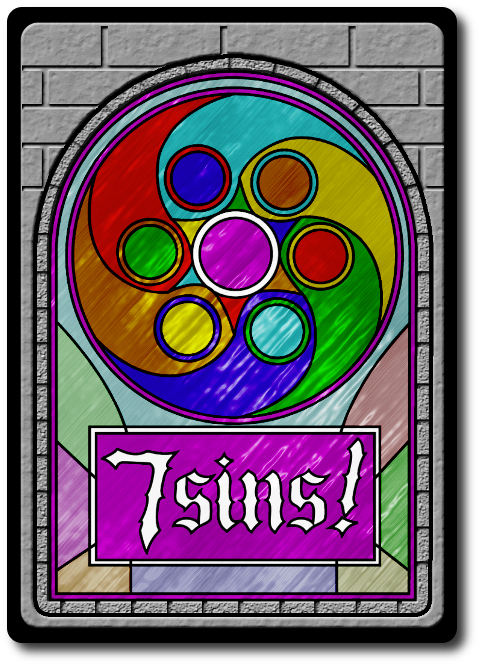
The Basics:
- For Ages 10 and up (publisher suggests 13+)
- For 3 to 7 players
- Variable game play length
Geek Skills:
- Counting & Math
- Logical & Critical Decision Making
- Reading
- Strategy & Tactics
- Risk vs. Reward
- Hand/Resource Management
Learning Curve:
- Child – Easy
- Adult – Easy
Theme & Narrative:
- Is it better to be really bad or just bad enough?
Endorsements:
- Gamer Geek approved!
- Parent Geek mixed!
- Child Geek approved!
Overview
Marilyn Monroe said, “I am good, but not an angel. I do sin, but I am not the devil.” In this game, players will collect Sin cards, each representing one of the “Seven Deadly Sins” (also known as capital vices or cardinal sins). The number of sins collected will need to be carefully controlled. Collect too many or not enough and you won’t win. It’s a balancing act between vice and virtue. In order to be the worst, you have to play the best.
7Sins!, designed by Kent Raquet and to be published by INWAP Games, will reportedly be comprised of 20 Wrath cards, 20 Greed cards, 20 Lust cards, 20 Pride card, 25 Gluttony cards, 20 Envy cards, 20 Sloth cards, and 28 Original Sin cards. As this is a review of the game’s prototype, we will not comment on the game component quality.
Game Set Up
First, separate all the cards int 5 different piles. These will be the Original Sin deck, the Main deck, the Gluttony deck, the Envy deck, and the Sloth deck.
Second, shuffle the Original Sin deck and deal 4 cards to each player, face-down. Players now take their dealt hand and select 2 of the cards to keep. The other 2 cards are now passed. One is given to the opponent on the payer’s right and the other is given to the opponent on the player’s left. Each player should now have 4 Original Sin cards (2 they kept and 2 they were passed). Place these cards face-down and to the side. Players will use them during the game’s final scoring. While these cards are not in direct play, they can be looked at any time during the game by their owner.
Third, shuffle the Main , Gluttony, Envy, and Sloth decks separately. The Main deck is comprised of “Wrath”, “Pride”, “Greed”, and “Lust” Sin cards (they all have the same card backs). Deal each player 3 cards, face-down, from each deck for a total of 12 cards. Then place each deck face-down in the middle of the playing area. These are the draw decks for the duration of the game. The cards dealt to the player are their starting hand.
When done, your playing area might look something like the following:
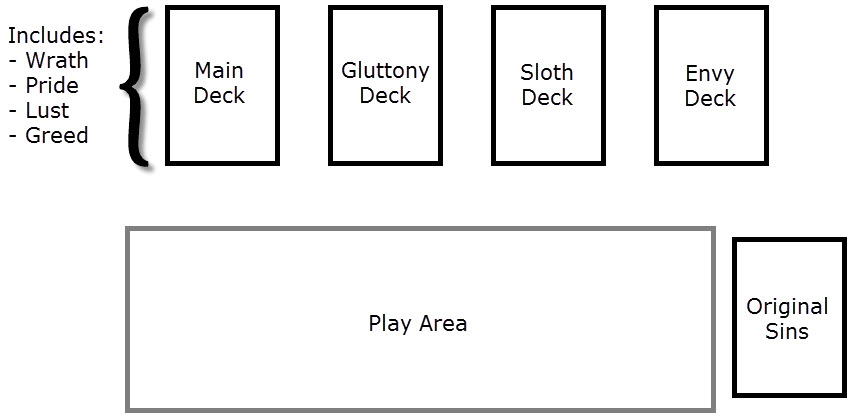
That’s it for game set up. Before playing, making sure every player has enough room in front of them to play cards. Determine who will go first and begin.
Playing the Game
Note: 7Sins! makes use of the “Seven Deadly Sins” as titles for the different Sin card types in the game. It does not discuss, portray, or embellish any subject matter on the topic of damnation or temptation. Nor does it discuss or make mention of any specific religious dogma. Those who are looking for a religious themed game will be disappointed and those who shy away from heavy-handed morality games have nothing to fear.
7Sins! is played in turns with no set number of turns per game. A player’s turn is summarized here.
Step 1: Play One Card
The player selects 1 Sin card from their hand and plays it to their Play Area, face-up. The one exception is the “Wrath” Sin cards (explained in step 2 below). The Play Area is directly in front of the player and is used to organize all the Sin cards played. Sin cards of the same type should be played to the same pile and organized in such a way so as to allow all opponents to easily see individual values of all the cards collected so far. Each pile is referred to as a “Sin stack”. In total, a player will have 7 Sin stacks (one for each Sin card type). The player’s Original Sin cards are not part of the player’s Play Area.
There is one exception to this rule. Sloth cards can always be drawn from the Sloth draw deck and played, even if a player has cards in their hand.
Step 2: Resolve Card
The Sin card played might direct the player to take another action. The player must resolve the action before continuing. Each Sin card type is summarized here.
Wrath
The “Wrath” Sin cards are played from the player’s hand to an opponent’s Play Area. This gives an opponent points, but it also allows the player to semi-control the total number of Wrath points an opponent has.
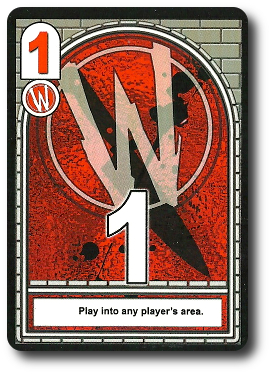
Lust
The “Lust” Sin cards are played to the player’s Play Area and allow the player to select an opponent who must now play a Sin card from their hand and resolve it. However, the opponent does NOT get to draw another Sin card to replace it. This could create a chain of events that must be resolved in order in which the cards are played.
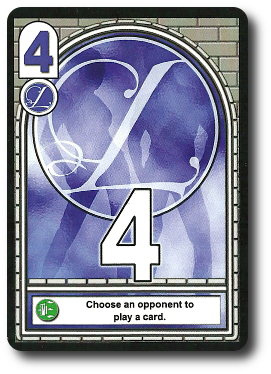
Greed
The “Greed” Sin cards are played to the player’s Play Area and allow the player to select an opponent who must give 1 of their Sin cards in their hand to the player. The opponent can select any card they like and does not get to draw a new card to replace it. The given card cannot be played this turn.
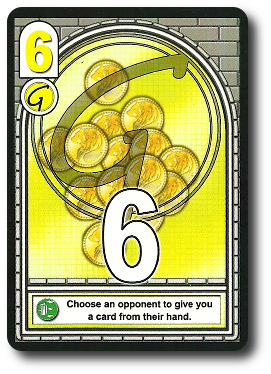
Sloth
The “Sloth” Sin cards are played to the player’s Play Area and allow the player to draw 1 card from any draw deck, adding it to their hand. “Sloth” Sin cards can also be drawn directly from the deck and played during step 1 of a player’s turn. Additionally, if a player is ever forced to play a card and cannot, they must draw and play a “Sloth” Sin card.

Pride
The “Pride” Sin cards are played to the player’s Play area and have no effect. They are used to trigger the end of game scoring.
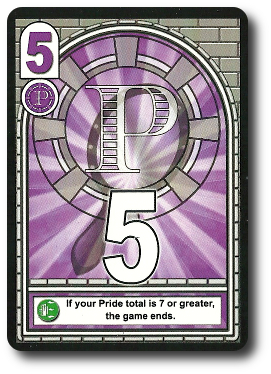
Envy
The “Envy” Sin cards are played to the player’s Play area and have no effect. They come into play when a Sin card is played that has the Envy symbol (a green “E”). When the player does play a card with the Envy symbol, they first resolve the Envy effect. The Envy effect forces 1 opponent to draw 1 “Envy” Sin card and play it to their Play Area. Then the player resolves the effect of the Sin card they played for their turn. In this way, 1 Sin card could impact 1 opponent twice or 2 opponents once. For example, a player could play a “Lust” Sin card to their Play Area that has an Envy symbol. They tell the opponent to their right to draw and place an “Envy” Sin card in their Play Area. Then they have the same opponent play a Sin card from their hand, resolving the “Lust” Sin card effect.

Gluttony
The Gluttony cards can only be played if there are fewer Gluttony cards in the player’s Play Area than the total number of Sin cards in the largest Sin stack. For example, if the player had 5 “Wrath” Sin cards, 4 “Envy” Sin cards, and 1 “Greed” Sin card in their Play Area, the player could have up to 5 “Gluttony” Sin cards to match the total number of cards in the “Wrath” Sin stack.
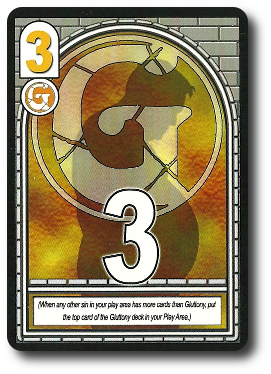
Step 3: Draw One Card
When the player is done playing 1 Sin card and resolving it, they draw 1 Sin card from the Main draw deck. Players will always draw 1 Sin card at the end of their turn. At no time will a player draw a card out of turn unless specifically directed to do so by a Sin card played by an opponent.
This ends the player’s turn. The next player in turn order sequence now takes their turn starting with step 1 noted above.
Ending the Game and Final Scoring
The game ends when any player has collected a total of 7 or more Pride points. This number is calculated by adding the number values on the “Pride” Sin cards, not the total number of cards in the Sin stack. Any cards still in the player’s hands are discarded.
Each player now takes their Original Sin cards and adds them to the matching Sin stack. For example, a “Pride” Original Sin card would be added to the player’s “Pride” Sin stack.
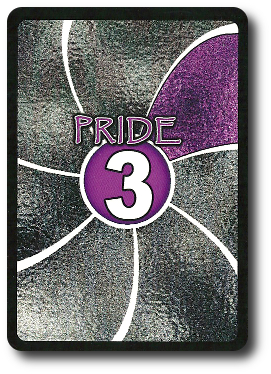
One at a time, each Sin stack is now evaluated. The number values of all the Sin cards in the Sin stack are added together and the total number of points are announced. The player with the highest total discards all the Sin cards in their Sin stack. All remaining players set their Sin stack to the side for final scoring.
For example, Player “A” had a total of 9 “Envy” points and Player “B” had a total of 7 “Envy” points. Since Player “A” had more total points, they discard their “Envy” Sin stack and Player “B” gets to keep theirs.
Each Sin stack is counted in turn until all 7 have been evaluated.
Now players combine their Sin stacks and add the number values of all the Sin cards they still have. The player with the highest score wins.
To learn more about 7Sins!, visit the game publisher’s website or visit the Kickstarter campaign.
Final Word
Note: All the Parent Geeks were hesitant to play a game with their family that had a title suggesting it dealt with some colorful topics. This was further reinforced by the “Lust” Sin card that has the silhouette of a man and woman standing akimbo. Personally, I thought it looked like two dancers (which makes a strange kind of sense), but some Parent Geeks thought the poses were sexually suggestive. It would be incorrect to suggest that 7Sins! morally upset or enraged any of our players, but it did make a number of them uncomfortable, resulting in 7Sins! not being shown to some of our younger players.
The Child Geeks understood the rules of the game without issue and jumped right in. They quickly learned how easy it was to collect Sin cards and didn’t realize that was a problem until after their first game. According to one Child Geek, “I forgot that you have to come in second if you want to finish first.” The Child Geek was commenting on the game’s final scoring where the player with the most points in a Sin stack loses all those points. The second game went just as smoothly, but took longer as the Child Geeks started to count the number of points in each Sin stack. The game’s slower pacing was noticed by more than a few of the Child Geeks. One Child Geek said, “This game got harder for some reason. I think because we are all adding numbers now.” Very possible. Or perhaps it got harder because the Child Geeks started to see the “game within the game”. It’s not nearly enough to collect as many points as possible. You must make sure you collect just enough points to win. Too big a lead will leave you with nothing. Another Child Geek said, “I like this game. It feels like you are watching everyone, but that’s kind of fun.” When all the cards were put away, the Child Geeks who played it found 7Sins! to be a game they enjoyed. Their Parent Geeks didn’t know how to feel about this…
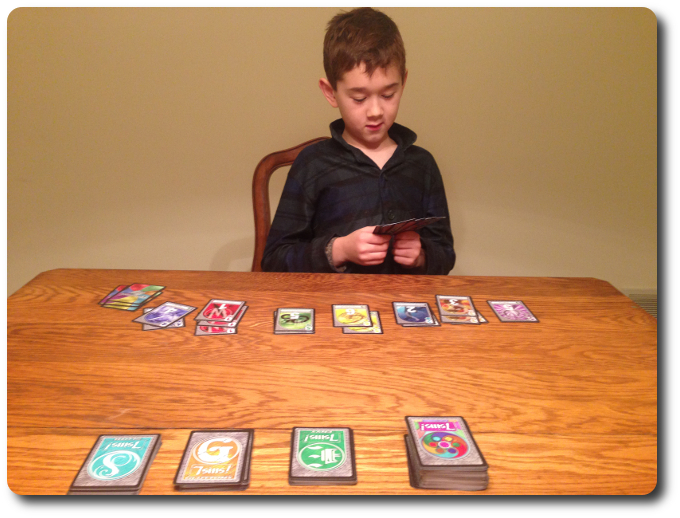
My son’s favorite part of the game was forcing other players to get and play cards
The Parent Geeks who played 7Sins! found the game to be easy to learn, easy to play, and surprisingly difficult to win. According to one Parent Geek, “I thought I understood this game right from the start, but I was really surprised I didn’t win. I guess I need to keep better track of my points.” Yes, but also your opponents’. I kept reminding the Parent Geeks that the “bigger sinner” is not the “biggest winner” in this game. The Parent Geeks understood that, but had a difficult time keeping just below the highest points. As one Parent Geek put it, “You have to always put yourself close to going over the edge and hope you don’t fall off.” The Parent Geeks liked this and found the game to be a wonderful exercise in hand and point management, surprise plays, pleasant backstabbing, and hoarding of cards. Unfortunately for 7Sins!, the game’s theme was a hurdle that could not be cleared. As one Parent Geek put it, “It’s a fun game with an unfortunate title and theme. It won’t be played with my friends and family as a result.” The Parent Geeks gave 7Sins! a mixed approval. Everyone enjoyed it, but not everyone wanted it on their table.
The Gamer Geeks had no moral objection to the game’s theme and found it interesting right from the start. According to one Gamer Geek, “I like what the game is doing and I don’t want it to end.” None of the Gamer Geeks wanted the game to end because they didn’t feel that they could win. This kept the games going longer than the other groups, but not less interesting. The second and subsequent games were much different and shorter, as the Gamer Geeks started to learn how to play smarter and more cutthroat. One Gamer Geek said, “This is an interesting set collecting game. I really like the ease of play and the subtle complexity of managing your Play Area.” Another Gamer Geek said, “You have to always take into account what Original Sin cards your opponents might have. If you don’t, you could lose the game.” When all the games were over, the Gamer Geeks 7Sins! their full approval.
I rather enjoyed this game and fully sympathize with the Parent Geeks. 7Sins! is not a game I would bring to entertain children or other adults that I didn’t know. Not because the game is too difficult, but because the first impression this game left on everyone was not welcoming. If you put a game in front of someone that appears to focus on immoral subjects, people are going to squirm. But it’s VERY important to note that 7Sins! has nothing to do with sin, morality, God, the Devil, the Flying Spaghetti Monster, Heaven, Hell, or Chuck E. Cheese’s (which is worse than Hell). There are no moral ambiguities to ponder or questionable slants to frown at. None. Zip. Zilch.
The only aspect of the game that I did not like was the text on the cards. They are poorly worded in some cases, which left our players scratching their head. A good example is the “Gluttony” Sin card. This card can only be placed in the Play Area if there are fewer Sin cards of any other type than the total number of “Gluttony” Sin cards in the same Play Area. OK, sure, but when? By other opponents? By the player? Is the player forced to play “Gluttony” Sin cards? Is it done as a secondary action to fulfill Gluttony’s purpose? The rules are unclear and so is the card. A quick FAQ or update to the game’s rules is all that is necessary, but questions like these leave players pondering the game’s playability. If players lose confidence in a game, it will never get played.
Games can take longer than expected or be surprisingly fast. It all depends on how aggressive the players are. I observed a game where one player placed as many “Pride” Sin cards as he could and as quickly as possible. After the game was over, he said he was trying to skunk the other players. He did, but he didn’t win. During another game, the “Pride” Sin cards were hardly ever played since the players were primarily focused on the other 6 Sin card types. The length of the game can range anywhere from 20 minutes to about 60 minutes, with an average game taking about 40 minutes. That’s not overly long in my book, but it can feel that way if you want the game to conclude to score your points. The number of players can also influence the game’s total length.
Overall, I can’t complain about 7Sins! It made me think, made me laugh, made grumble, and made me want to play more. I found it rather clever how the card actions matched the sins they portrayed, albeit in a very abstract way. There is also an excellent mix of information shared and information hidden during the game. Players can make some very education decisions, but not with full confidence. For example, the Main draw deck contains 4 Sin card types. Players don’t know what their opponents have until they are played. At which point, it might be too late. You have to plan given what you know and hope that what you don’t isn’t enough to nip you in the bud.
The biggest sin a player can commit in 7Sins! is being overconfident. You won’t know anything for certain until the points are counted. If this game sounds interesting to you, do give it a try. You won’t need to go to confession after you play the game, but you will most likely want to talk about.
This is a paid for review of the game’s final prototype. Although our time and focus was financially compensated, our words are our own. We’d need at least 10 million dollars before we started saying what other people wanted. Such is the statuesque and legendary integrity of Father Geek which cannot be bought except by those who own their own private islands and small countries.



